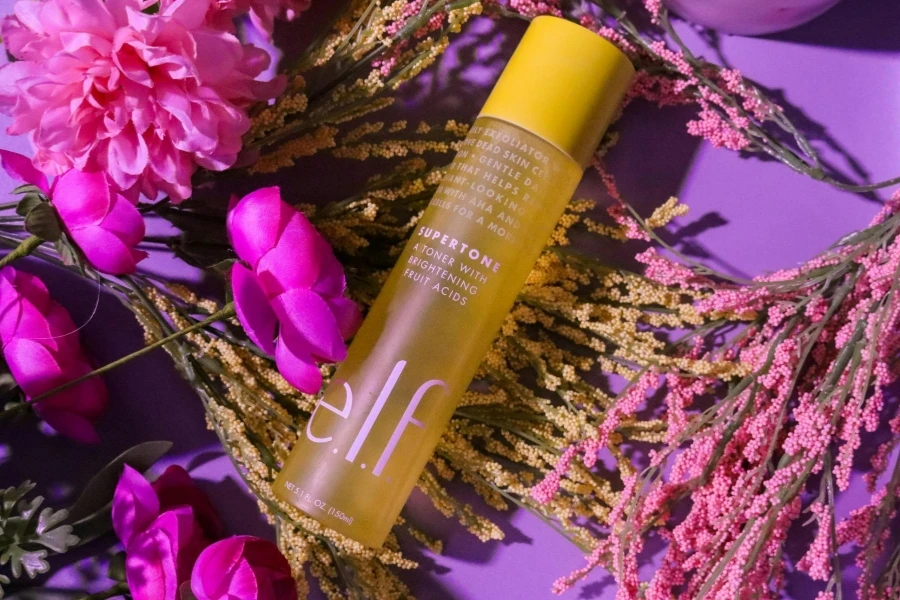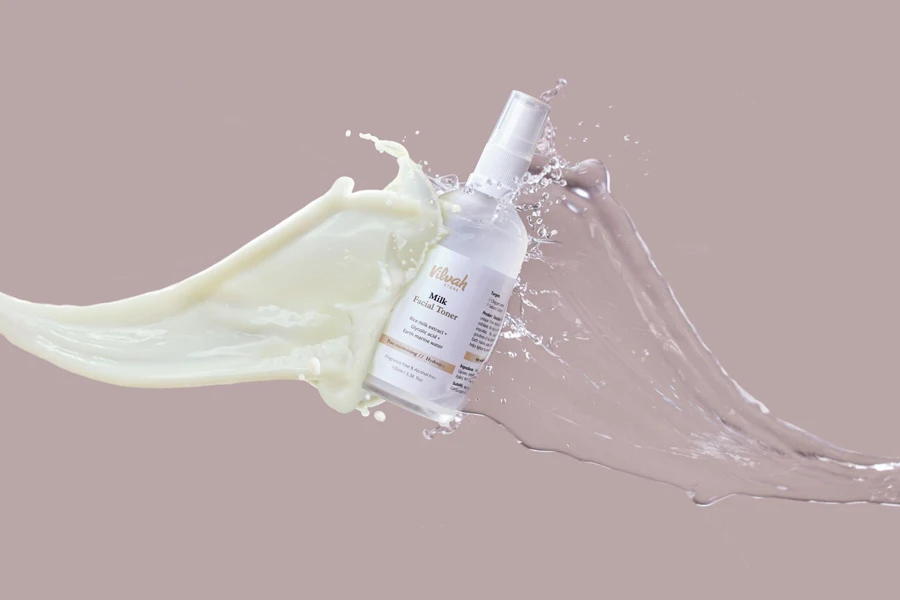Table of Contents
1. Introduction
2. Understanding the main types and uses of skin toners
3. Market overview for skin toner for 2025
4. Key considerations when selecting skin toners
5. Leading skin toner models and their features
6. Conclusion

Introduction
Skin toners are now a must-have in today’s skincare regimens as they provide advantages that improve overall skin wellness. These products are usually used after cleansing and moisturizing to maintain the skin’s pH levels and eliminate any remaining impurities while priming the skin to absorb following treatments. Containing components such as acid, salicylic acid, and green tea extract, toners can moisturize, exfoliate, and calm the skin effectively. Their versatility in tackling skin issues like dryness and acne makes them a great choice for any skincare routine and emphasizes the importance of making informed decisions for the upcoming year 2025.
Understanding the main types and uses of skin toners
Skin toners have become a part of skincare regimens because of their diverse benefits that cater to different skin types and specific needs, making them versatile products in the beauty routine world. Let’s delve into the types and purposes of skin toners for a more comprehensive understanding.
Hydrating toners: Tare specially designed to provide moisture and calm the skin using ingredients like niacinamide for skin elasticity and tone improvement, acid for retaining moisture, and aloe vera for its calming and anti-inflammatory effects, ideal for sensitive or irritated skin. These toners work well for people with sensitive skin as they help moisturize and reduce any discomfort from dryness.
Exfoliating toners: Exfoliating toners help eliminate skin cells and unclog pores while fighting acne using salicylic acid and glycolic acid, which penetrate deeply into the skin to remove impurities and improve skin texture through gentle exfoliation. Another type of AHA, known as acid, is gentler and brightens the skin while offering a mild exfoliating effect. These toners are great for individuals with skin and acne issues as they assist in keeping the skin clear and smooth by warding off breakouts and improving skin quality.

Calming toners: These toning solutions can eliminate inflammation and redness; hence, they are recommended for sensitive-skinned individuals. The most common ingredients featured are hypochlorous acid and green tea extract. Hypochlorous acid, a hypohalite, shows antimicrobial activity and can reduce skin inflammation, while green tea extract is an antioxidant that helps preserve skin from environmental aggressions. Some of the major functions these toners offer include serving as a skin equalizer that helps reduce skin inflammation, which is common for sensitive skin and also works as a skin healer with the capabilities of enhancing the appearance of skin. It is perfect for those sensitive skin as it does not cause the skin to become irritated or red.
Multi-use toners: Multi-purpose toners benefit by combining hydration and exfoliation in one convenient skincare product solution. They typically contain a mix of skin-loving ingredients like acid for moisture and exfoliating agents like AHAs or BHAs for smooth skin. For example, a toner could blend the hydrating properties of acid with the exfoliating qualities of glycolic acid to enhance skin texture and keep the skin hydrated and balanced. With their ability to meet a variety of skincare needs effectively and efficiently in one go, these products are a choice for anyone wanting to simplify their skincare regimen. They’re especially handy for people who want to hydrate and exfoliate without using several different products simultaneously.
Market overview for skin toner for 2025
Market growth and trends: According to experts, the global market for skin toner is estimated to be worth USD 5.1 billion in 2024. Current projections suggest that the market will expand to USD 7.5 billion by 2029 with a CAGR of 8% from 2024 to 2029. This upsurge in market size is primarily fueled by the rising popularity of creams, sunscreens, and body lotions on a global scale. The growth of the beauty industry is driven by trends such as the increasing popularity of clean beauty products free from harmful chemicals and environmentally friendly packaging that attracts consumers who care about the planet’s well-being. Moreover, there is a rising demand for purpose skincare products that offer multiple benefits in a single formula to simplify and streamline daily skincare routines.

Consumer preferences: Consumers increasingly favor skincare products with organic ingredients over synthetic chemicals. This is in response to evolving preferences and concerns for safety and efficacy in the beauty industry market. Demand is growing for cruelty-free and vegan formulations that resonate with ethical values related to animal welfare and eco-friendliness. This shift in consumer preferences drives purchasing behaviors as individuals seek products that mirror their beliefs regarding environmental sustainability and compassion towards animals.
Key players in the market: Major companies in the skincare industry hold influence due to their strong commitment to research and development. They also can introduce innovative products through widespread distribution channels and effective marketing campaigns. These top brands consistently allocate resources towards creating products and implementing strategic marketing approaches to stay ahead in the market competition. Moreover, growing brands are making a mark by launching efficient formulas tailored to meet specific demands of consumers like those with sensitive skin or seeking anti-aging remedies. In this changing market environment, there is a strong emphasis on innovation and adapting to the ever-evolving needs of consumers.

In 2024, the skin toner market will be lively. Filled with competition due to well-informed consumers and creative product options available in the market today. Understanding these dynamics can enable companies to tailor their strategies to market needs and seize growth prospects.
Key considerations when selecting skin toners
Picking the skin toner requires considering different aspects that can influence how well it works and whether it matches various skin types and requirements. Here are some important things to consider.
Skin type compatibility: For skin types needing oil control and breakout prevention, opt for salicylic or glycolic acid toners. These ingredients help exfoliate the skin and clear out pores for a complexion. On the other hand, dry skin needs toners with hydrating components such as hyaluronic acid, niacinamide, and aloe vera to moisturize and soothe the irritation. For skin types to stay happy and healthy, opting for gentle products containing soothing elements like green tea extract and hypochlorous acid to calm any redness or irritation is best. Those with combination skin can benefit from toners that work well on both dry patches, ensuring a good balance in moisture levels and skin texture.
Ingredient efficacy: The performance of a toner is greatly influenced by its ingredients, such as acid and salicylic acid, which are crucial for its effectiveness and quality results. Hyaluronic acid acts as a moisturizer that draws moisture to the skin. In contrast, salicylic acid works deep within the pores to cleanse impurities. Moreover, glycolic acid aids in enhancing skin texture by boosting cell regeneration. Avoid harmful substances, like alcohol and parabens, as they can strip away the skin’s natural oils and lead to dryness or irritation. Choosing alcohol-free products helps maintain the skin’s moisture levels and keeps it healthy.

Product formulation: Different types of toners are available in the market with varying formulations such as liquids, sprays, and pads, each having advantages. Liquid toners are widely used. It can be applied using a cotton pad or simply with hands for better coverage. Spray toners offer a revitalizing mist that can be used anytime during the day to hydrate the skin quickly. Toner pads come pre-soaked. They are handy for travel or when you’re out and about to ensure a consistent application experience. Knowing the variances in these formulations can assist in choosing the application method that aligns with personal preferences and skincare habits.
Packaging and sustainability: Sustainability and packaging go hand in hand in today’s market, with eco-packaging playing a crucial role that cannot be ignored. In the skincare industry, consumers are leaning towards products packaged in materials or minimal packaging to lessen their environmental footprint. Brands that provide choices are catching the eye of consumers increasingly seeking environmentally conscious products. Glass bottles, biodegradable packaging, and refillable options are emerging trends that aim to cut down waste and support sustainability efforts within the skincare sector.
Price vs. value: Assessing the price versus value dilemma when considering a toner is crucial for making an informed buying decision. High-end toners may boast top-quality ingredients and advanced formulations; however, determining if the added perks are worth the expense is vital. On the other hand, economical alternatives can provide great value as long as they include powerful ingredients and deliver on their promises. Discovering the top value option requires examining product characteristics, reviewing ingredients, and gaining customer feedback to select the toner that provides advantages at an affordable cost.
Considering these aspects, companies must choose the right skin toners for their product ranges to cater to a wide range of customer requirements and maintain a competitive edge in the thriving skincare industry.
Leading skin toner models and their features

When assessing skin toners’ effectiveness and suitability for skin types and needs, it is important to consider a variety of factors that set them apart from each other, such as the ingredients used in the products and how well they work with various skin types, as well as their specific benefits and reputation of the brand creating them This structured approach allows for a thorough evaluation of toner options giving professionals in the industry and online sellers the ability to choose the most fitting products, for their customers Some well-known brands excel in these areas and are thus highly regarded in the market.
It’s essential to consider the ingredients used carefully. Popular ingredients often found in these toners include hydrating components such as acid and glycerin that help attract moisture and are great for people with dry skin. Exfoliating agents like alpha acids (AHAs) and beta hydroxy acids (BHAs) are key for toners that improve skin texture and encourage cell turnover. Additionally, ingredients like chamomile and aloe vera are important in formulations aimed at soothing skin by reducing redness and irritation. Considering the potential irritants such as alcohol is crucial as it can remove the skin’s oils and result in dryness and sensitivity issues to be aware of in skincare routines. Moreover, infusing toners with extracts, antioxidants, and peptides can boost their effectiveness by offering anti-aging benefits and shielding the skin from environmental factors that cause stress.
Ensuring that toners are suitable for skin types is also crucially important. Criteria such as these require toners to be meticulously crafted to cater to the needs of various skin types. Ranging from oily and prone to acne to dry and sensitive skin.For instance, treatments for skin commonly feature components like salicylic acid or witch hazel. It helps in regulating sebum production and reducing the appearance of pores. Nourishing toners intended for dry skin should contain moisturizing agents and emollients. This aids in restoring moisture and preventing water loss through the epidermis. When creating items for skin types, it is important to use mild and hypoallergenic ingredients while avoiding typical irritants and allergens in the formulation process to cater to various customer needs in the retail sector effectively.
Photo credit goes to Pexels.

The advantages of using a toner depend greatly upon the ingredients it contains and its intended purpose. Hydrating toners help lock in moisture, especially in dry weather conditions or when the skin is prone to dehydration during colder seasons. Exfoliating toners aid in achieving a brighter skin tone by eliminating dead skin cells and promoting cell renewal. Soothing toners are essential for individuals with easily reactive skin as they work wonders in alleviating redness and preserving a harmonious complexion. Retailers can better address skincare needs by offering anti-age toners with antioxidants and peptides to boost collagen production and shield against free radical harm, which helps minimize aging effects.
A brand’s reputation is crucial when it comes to assessing skin toners. Known brands with a track record of creating top-notch skincare items tend to gain more trust and loyalty from consumers. These brands usually put effort into research and development to ensure their products are effective and safe for regular usage. Brand products are more likely to undergo dermatologist testing and be free from harmful additives, a key consideration for online retailers and professionals looking to uphold a trustworthy product selection. Collaborating with companies can enrich the overall customer journey and result in increased levels of satisfaction among customers.

Conclusion
Picking the skin toner is vital in improving skin wellness and effectively targeting individual skincare requirements for optimal results. Businesses must stay updated on skincare trends and product advancements to meet their customers’ changing needs effectively. Professionals who know the toners available today can confidently choose products with key ingredients that align with diverse skin types and concerns. The market for skin toners is set to expand due to consumer demand for sustainable products that work well. It’s important to keep up with the latest developments and changes in the market.





 বাংলা
বাংলা Nederlands
Nederlands English
English Français
Français Deutsch
Deutsch हिन्दी
हिन्दी Bahasa Indonesia
Bahasa Indonesia Italiano
Italiano 日本語
日本語 한국어
한국어 Bahasa Melayu
Bahasa Melayu മലയാളം
മലയാളം پښتو
پښتو فارسی
فارسی Polski
Polski Português
Português Русский
Русский Español
Español Kiswahili
Kiswahili ไทย
ไทย Türkçe
Türkçe اردو
اردو Tiếng Việt
Tiếng Việt isiXhosa
isiXhosa Zulu
Zulu